Operation Cycle of Diesel CR Injection Pump via Pressure Measurement in Piston Working Chamber
Abstract
:1. Introduction
2. Materials and Methods
2.1. Experimental Set-Up
2.2. Tested Fluids
2.3. Test Cases
3. Results and Discussion
3.1. Piston Displacement and Swept Volume
3.2. Pump Operation (Reference Fluid)
3.3. Pure Fluids
3.4. Fuel Blends
4. Conclusions
Author Contributions
Funding
Institutional Review Board Statement
Informed Consent Statement
Data Availability Statement
Acknowledgments
Conflicts of Interest
References
- Payri, R.; Serrano, J.R.; Tormos, B.; Gomez-Vilanova, A. An objective reflection about the potential future of diesel vehicles against arguments based on energy populism. Dyna (Spain) 2019, 94, 480–482. [Google Scholar] [CrossRef]
- Jaliliantabar, F.; Ghobadian, B.; Carlucci, A.P.; Najafi, G.; Mamat, R.; Ficarella, A.; Strafella, L.; Santino, A.; De Domenico, S. A comprehensive study on the effect of pilot injection, EGR rate, IMEP and biodiesel characteristics on a CRDI diesel engine. Energy 2020, 194, 116860. [Google Scholar] [CrossRef]
- Jain, A.; Krishnasamy, A.; Pradeep, V. Computational optimization of reactivity controlled compression ignition combustion to achieve high efficiency and clean combustion. Int. J. Engine Res. 2021, 22, 2213–2232. [Google Scholar] [CrossRef]
- Hoang, A.T. Combustion behavior, performance and emission characteristics of diesel engine fuelled with biodiesel containing cerium oxide nanoparticles: A review. Fuel Process. Technol. 2021, 218, 106840. [Google Scholar] [CrossRef]
- Khan, Z.A.; Saeed, A.; Gregory, O.; Ghafoor, A. Biodiesel performance within internal combustion engine fuel system—A review. Tribol. Ind. 2016, 38, 197–213. [Google Scholar]
- Ragupathi, K.; Mani, I. Durability and lube oil contamination study on diesel engine fueled with various alternative fuels: A review. Energy Sources Part A Recovery Util. Environ. Eff. 2021, 43, 932–943. [Google Scholar] [CrossRef]
- Algayyim, S.J.M.; Wandel, A.P. Macroscopic and microscopic characteristics of biofuel spray (biodiesel and alcohols) in CI engines: A review. Fuel 2021, 292, 120303. [Google Scholar] [CrossRef]
- Hoang, A.T.; Tabatabaei, M.; Aghbashlo, M.; Carlucci, A.P.; Ölçer, A.I.; Le, A.T.; Ghassemi, A. Rice bran oil-based biodiesel as a promising renewable fuel alternative to petrodiesel: A review. Renew. Sustain. Energy Rev. 2021, 135, 110204. [Google Scholar] [CrossRef]
- Agarwal, A.K.; Park, S.; Dhar, A.; Lee, C.S.; Park, S.; Gupta, T.; Gupta, N.K. Review of experimental and computational studies on spray, combustion, performance, and emission characteristics of biodiesel fueled engines. J. Energy Resour. Technol. Trans. ASME 2018, 140. [Google Scholar] [CrossRef] [Green Version]
- Chiatti, G.; Chiavola, O.; Palmieri, F. Impact on combustion and emissions of jet fuel as additive in diesel engine fueled with blends of petrol diesel, renewable diesel and waste cooking oil biodiesel. Energies 2019, 12, 2488. [Google Scholar] [CrossRef] [Green Version]
- Ma, Q.; Zhang, Q.; Liang, J.; Yang, C. The performance and emissions characteristics of diesel/biodiesel/alcohol blends in a diesel engine. Energy Rep. 2021, 7, 1016–1024. [Google Scholar] [CrossRef]
- Agarwal, A.K.; Agarwal, D. Field-testing of biodiesel (B100) and diesel-fueled vehicles: Part 3-wear assessment of liner and piston rings, engine deposits, and operational issues. J. Energy Resour. Technol. Trans. ASME 2021, 143. [Google Scholar] [CrossRef]
- Mata, C.; Piaszyk, J.; Soriano, J.A.; Herreros, J.M.; Tsolakis, A.; Dearn, K. Impact of alternative paraffinic fuels on the durability of a modern common rail injection system. Energies 2020, 13, 4166. [Google Scholar] [CrossRef]
- Yildiz, I.; Caliskan, H.; Mori, K. Energy, exergy and environmental assessments of biodiesel and diesel fuels for an internal combustion engine using silicon carbide particulate filter. J. Therm. Anal. Calorim. 2021, 145, 739–750. [Google Scholar] [CrossRef]
- Macián, V.; Tormos, B.; Bermúdez, V.; Bastidas, S. Development of a floating liner test rig and lubrication model for the study of the piston compression ring friction force under fully flooded and starved lubrication. Tribol. Int. 2021, 160, 107034. [Google Scholar] [CrossRef]
- Yang, J.; Wu, J.; Zhang, Y.; Tao, W.; Fan, X.; Xie, P. Optimization Study on Key Parameters Influencing Friction and Slap Characteristics of Pistons. Neiranji Gongcheng/Chin. Intern. Combust. Engine Eng. 2021, 42, 95–103. [Google Scholar] [CrossRef]
- Lyu, Y.J.; Kang, J.X.; Zhang, Y.F.; Luo, H.B. Research progress of anti-friction and anti-wear of piston-cylinder liner system in internal combustion engine. Jiaotong Yunshu Gongcheng Xuebao/J. Traffic Transp. Eng. 2020, 20, 21–34. [Google Scholar] [CrossRef]
- Jain, A.; Porpatham, E.; Thipse, S.S. Effect of intake valve timing, duration strategies with swirl ratio on volumetric efficiency of single cylinder diesel engine. Int. J. Mech. Prod. Eng. Res. Dev. 2020, 10, 415–434. [Google Scholar] [CrossRef]
- Moser, S.; Edwards, K.D.; Schoeffler, T.; Filipi, Z. CFD/FEA Co-Simulation Framework for Analysis of the Thermal Barrier Coating Design and Its Impact on the HD Diesel Engine Performance. Energies 2021, 14, 2044. [Google Scholar] [CrossRef]
- Magno, A.; Mancaruso, E.; Vaglieco, B.M. Effects of both blended and pure biodiesel on waste heat recovery potentiality and exhaust emissions of a small CI (compression ignition) engine. Energy 2015, 86, 661–671. [Google Scholar] [CrossRef]
- Catania, A.E.; Ferrari, A. Experimental analysis, modeling, and control of volumetric radial-piston pumps. J. Fluids Eng. Trans. ASME 2011, 133, 081103. [Google Scholar] [CrossRef]
- Qi, B.; Yong, Z. Tribological study of piston–cylinder interface of radial piston pump in high-pressure common rail system considering surface topography effect. Proc. Inst. Mech. Eng. Part J J. Eng. Tribol. 2020, 234, 1381–1395. [Google Scholar] [CrossRef]
- Wang, H.; Xiang, J.; Wang, C. Simulation of Micro Motion of Common Rail High-Pressure Fuel Pump Plunger. Neiranji Gongcheng/Chin. Intern. Combust. Engine Eng. 2019, 40, 65–71. [Google Scholar] [CrossRef]
- Iordache, R.C.; Petrea, N.D.; Bujoreanu, C. Wear’s Issues on High-Pressure Common Rail Pumps. In IOP Conference Series: Materials Science and Engineering; IOP Publishing: Bristol, UK, 2020; Volume 724. [Google Scholar]
- Petrea, N.D.; Bujoreanu, C.; Ripanu, I.E. Influence of Ball-Seat Contact on the Noise Emissions from Common-Rail Pump Outlet VALVE opening. In IOP Conference Series: Materials Science and Engineering; IOP Publishing: Bristol, UK, 2018; p. 042012. [Google Scholar]
- Petrea, N.D.; Bujoreanu, C.; Alaci, S. Analysis of the Noise Emissions of a Common-Rail Pump before and after an Endurance Test. In IOP Conference Series: Materials Science and Engineering; IOP Publishing: Bristol, UK, 2019. [Google Scholar]
- Rückert, M.; Murrenhoff, H.; Heitzig, S. Influence of a New Hollow Piston Design on Volumetric Losses of a Common-Rail Pump. In Proceedings of the ASME/BATH 2017 Symposium on Fluid Power and Motion Control, FPMC 2017, Sarasota, FL, USA, 16–19 October 2017. [Google Scholar]
- Yue, G.; Qiu, T.; Dai, H.; Lei, Y.; Zhao, N. Rail pressure control strategy based on pumping characteristics for the common rail fuel system. Adv. Mech. Eng. 2018, 10. [Google Scholar] [CrossRef]
- Ferrari, A.; Vitali, R. Instantaneous torque, energy saving and flow rate ripple analysis of a common rail pump equipped with different delivery-pressure control systems. Int. J. Engine Res. 2018, 19, 1036–1047. [Google Scholar] [CrossRef]
- Cavallo, M.D.; Chiavola, O.; Frattini, E.; Palmieri, F. Fuel Influence on Single-Piston Common Rail Pump Performance. In Proceedings of the 15th International Conference on Engines & Vehicles—Status, Capri, Italy, 12–16 September 2021. Accepted for publication 2021-24-0063. [Google Scholar]
- Botwinska, K.; Mruk, R.; Krawiec, L. Modelling of the work processes high-pressure pump of common rail diesel injection system. In Proceedings of the E3S Web of Conferences, Kraków, Poland, 17–19 May 2016. [Google Scholar]
- Catania, A.E.; Ferrari, A.; Mittica, A. High-pressure rotary pump performance in multi-jet common rail systems. In Proceedings of the 8th Biennial ASME Conference on Engineering Systems Design and Analysis (ESDA 2006), Torino, Italy, 4–7 July 2006. [Google Scholar]
- Giuffrida, A.; Ficarella, A.; Laforgia, D. Study of the delivery behaviour of a pump for common rail fuel injection equipment. Proc. Inst. Mech. Engineers. Part I J. Syst. Control Eng. 2009, 223, 521–535. [Google Scholar] [CrossRef]
- Bosch, R. Automotive Handbook, 10th ed.; Wiley: Hoboken, NJ, USA, 2019; p. 1750. [Google Scholar]
- Payri, R.; Salvador, F.J.; Gimeno, J.; Bracho, G. The effect of temperature and pressure on thermodynamic properties of diesel and biodiesel fuels. Fuel 2011, 90, 1172–1180. [Google Scholar] [CrossRef] [Green Version]




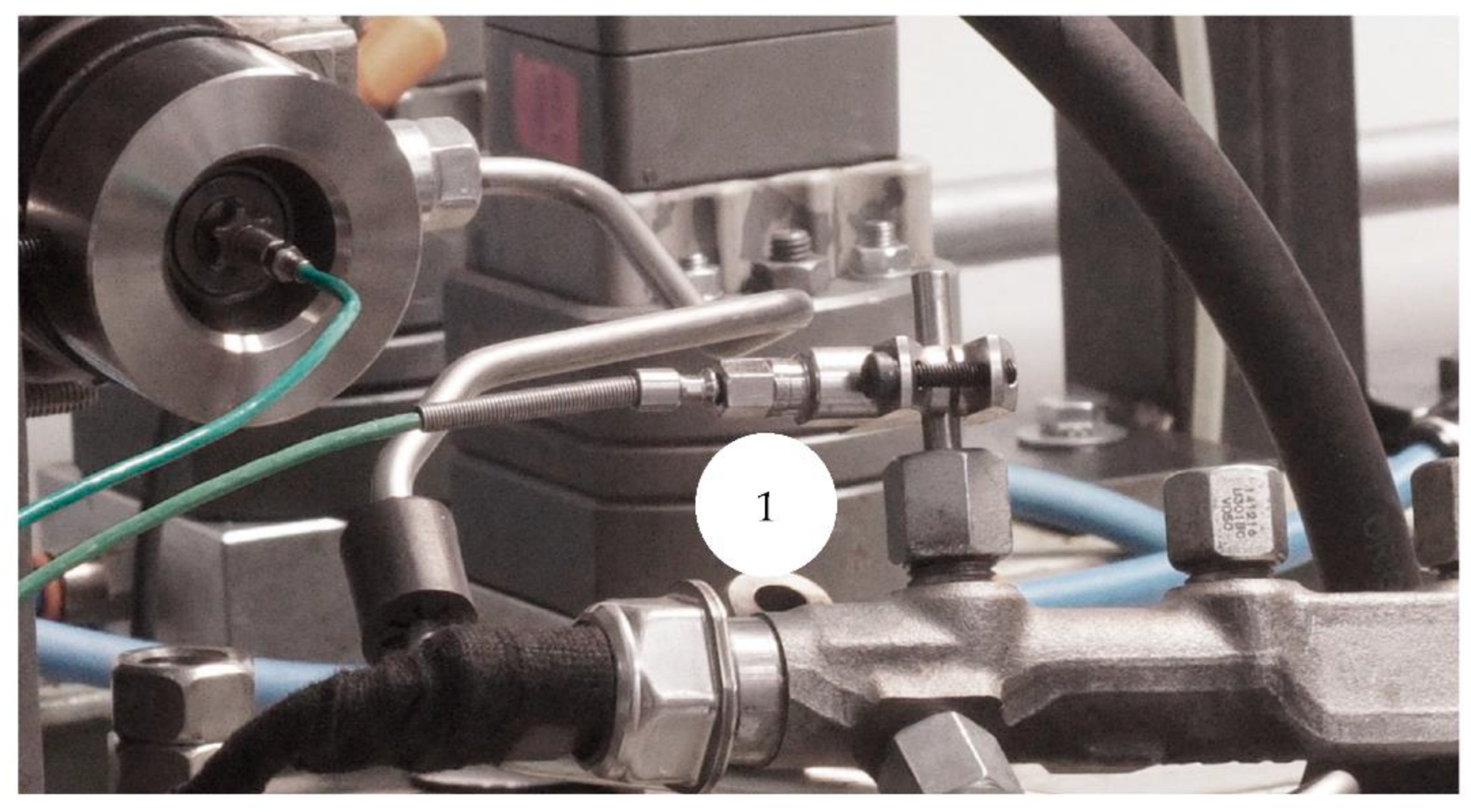
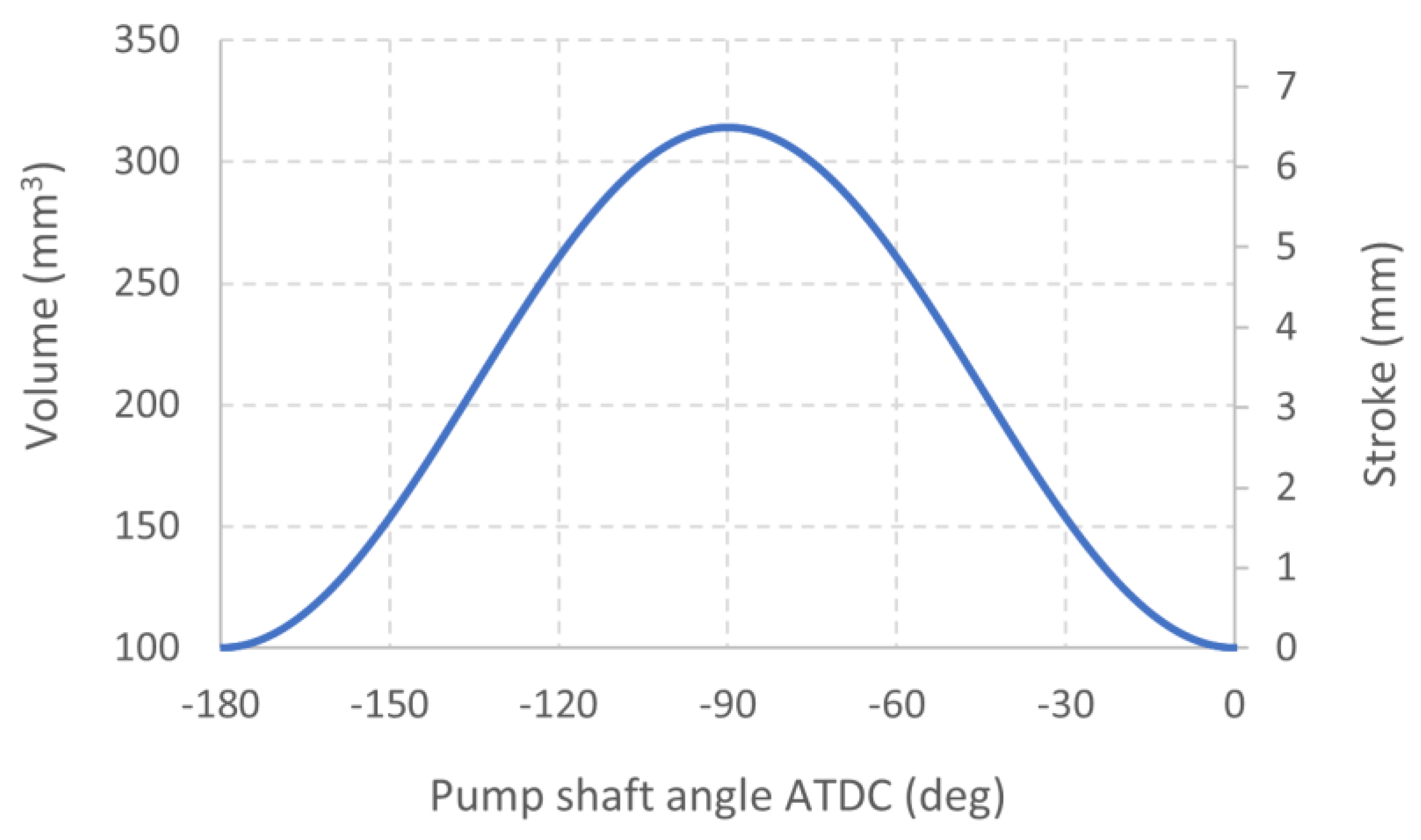

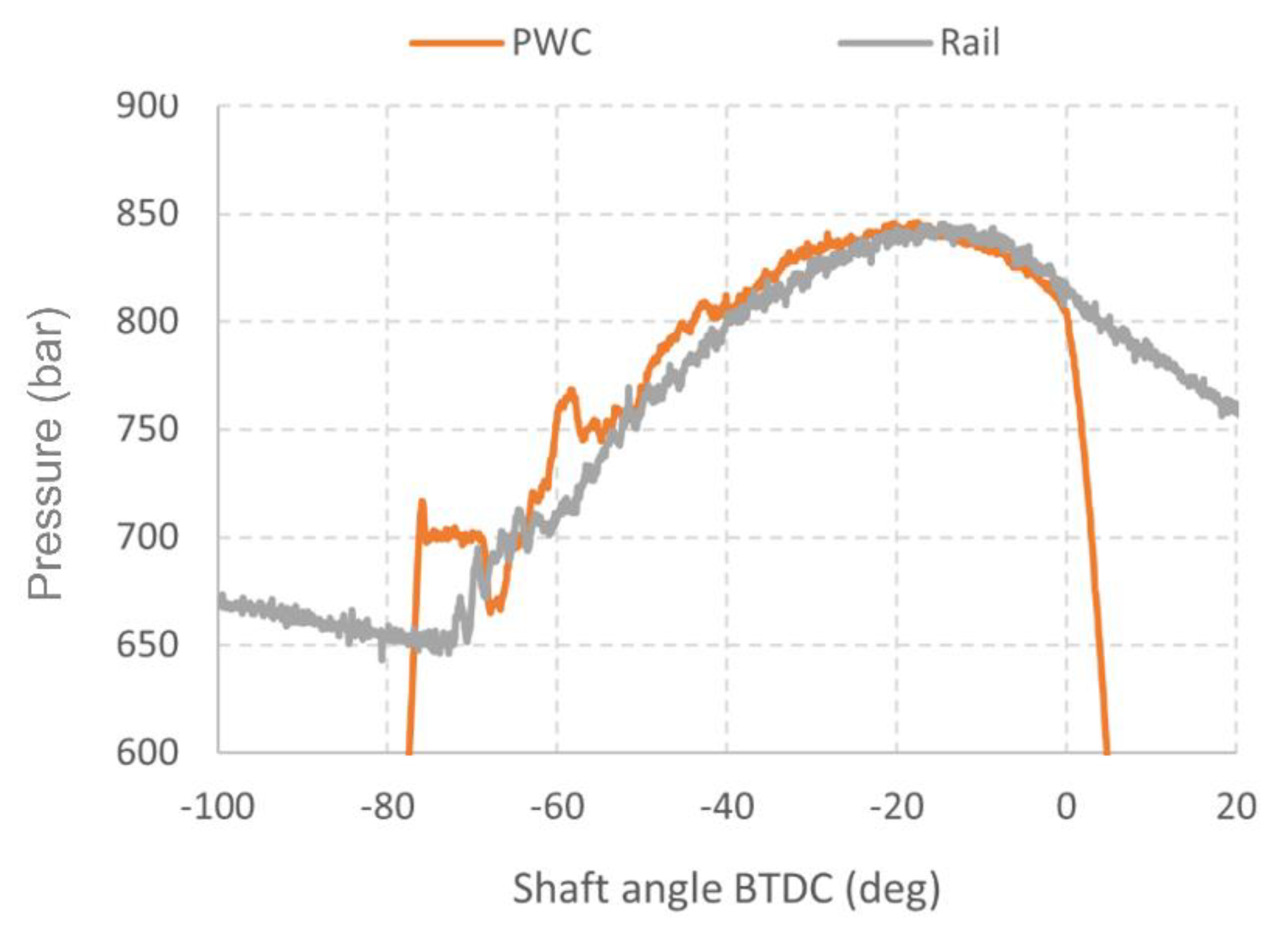

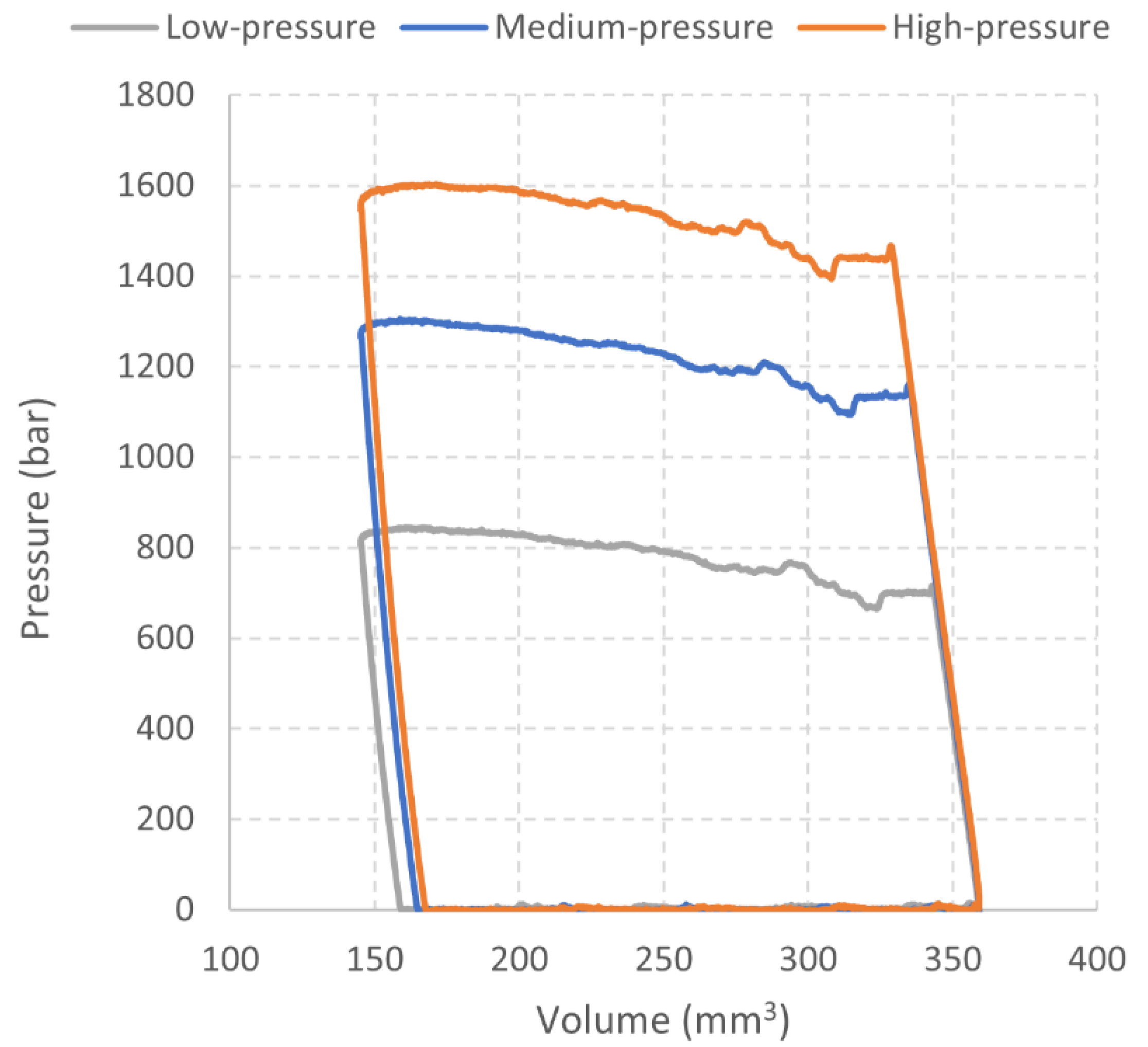



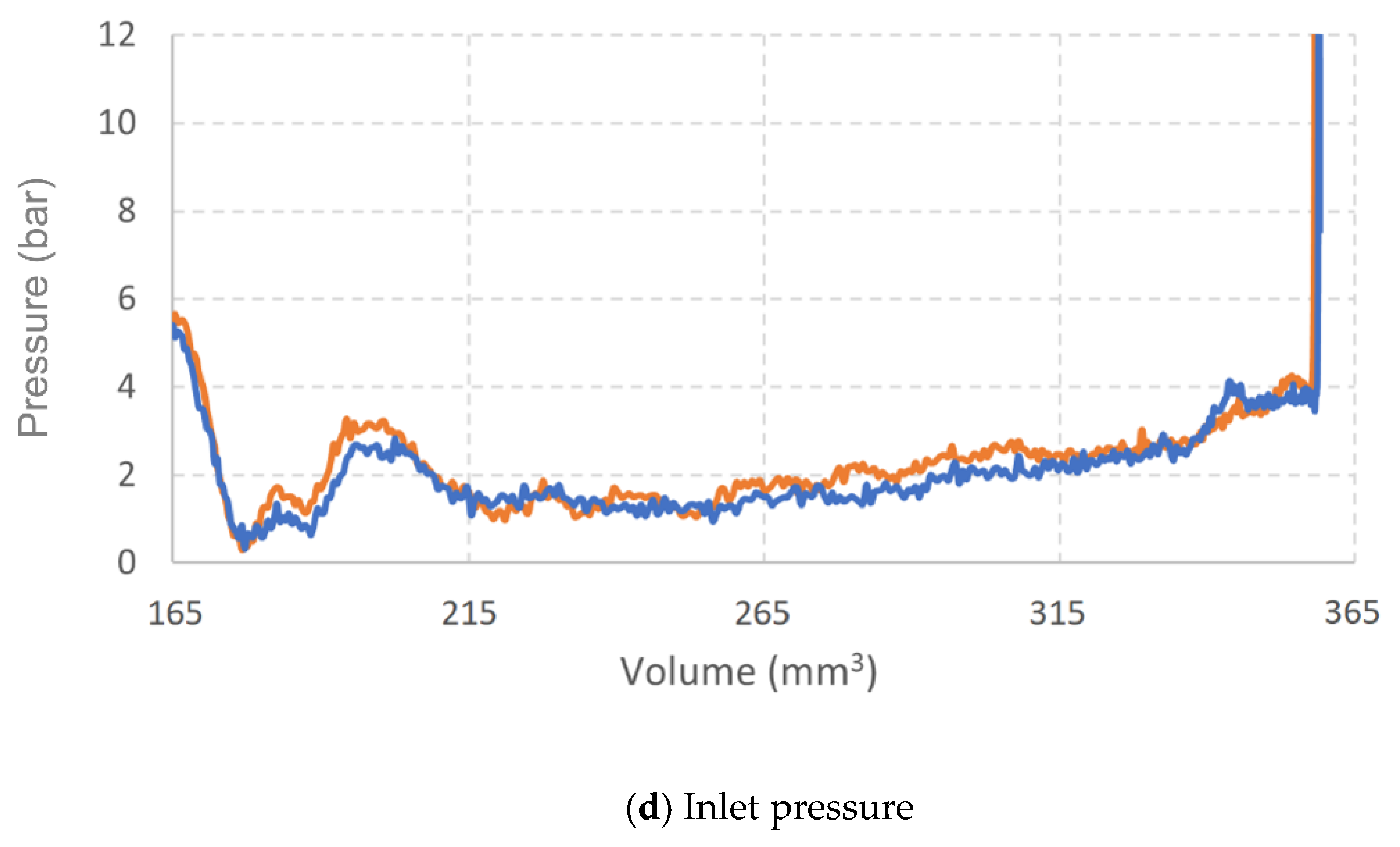

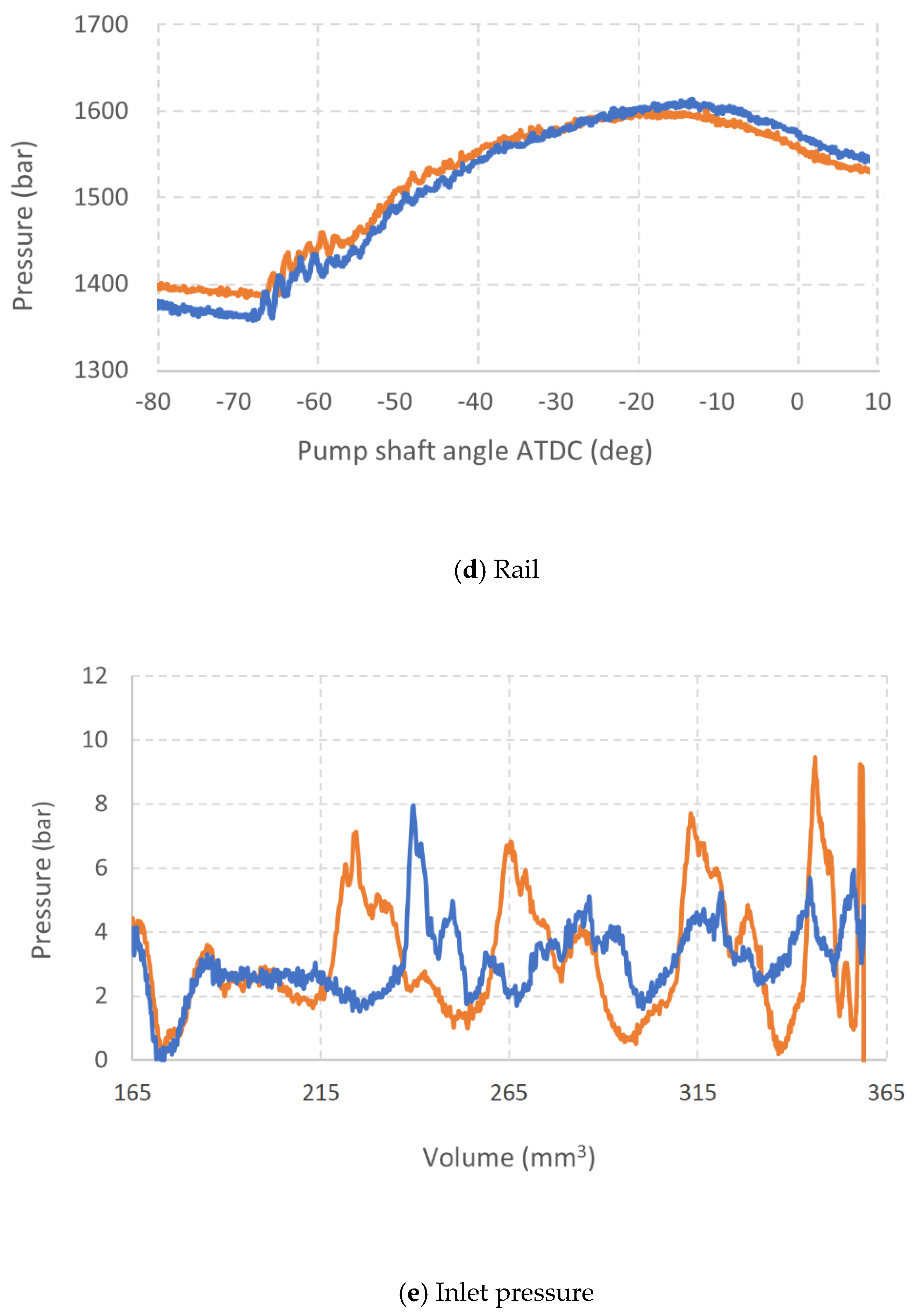
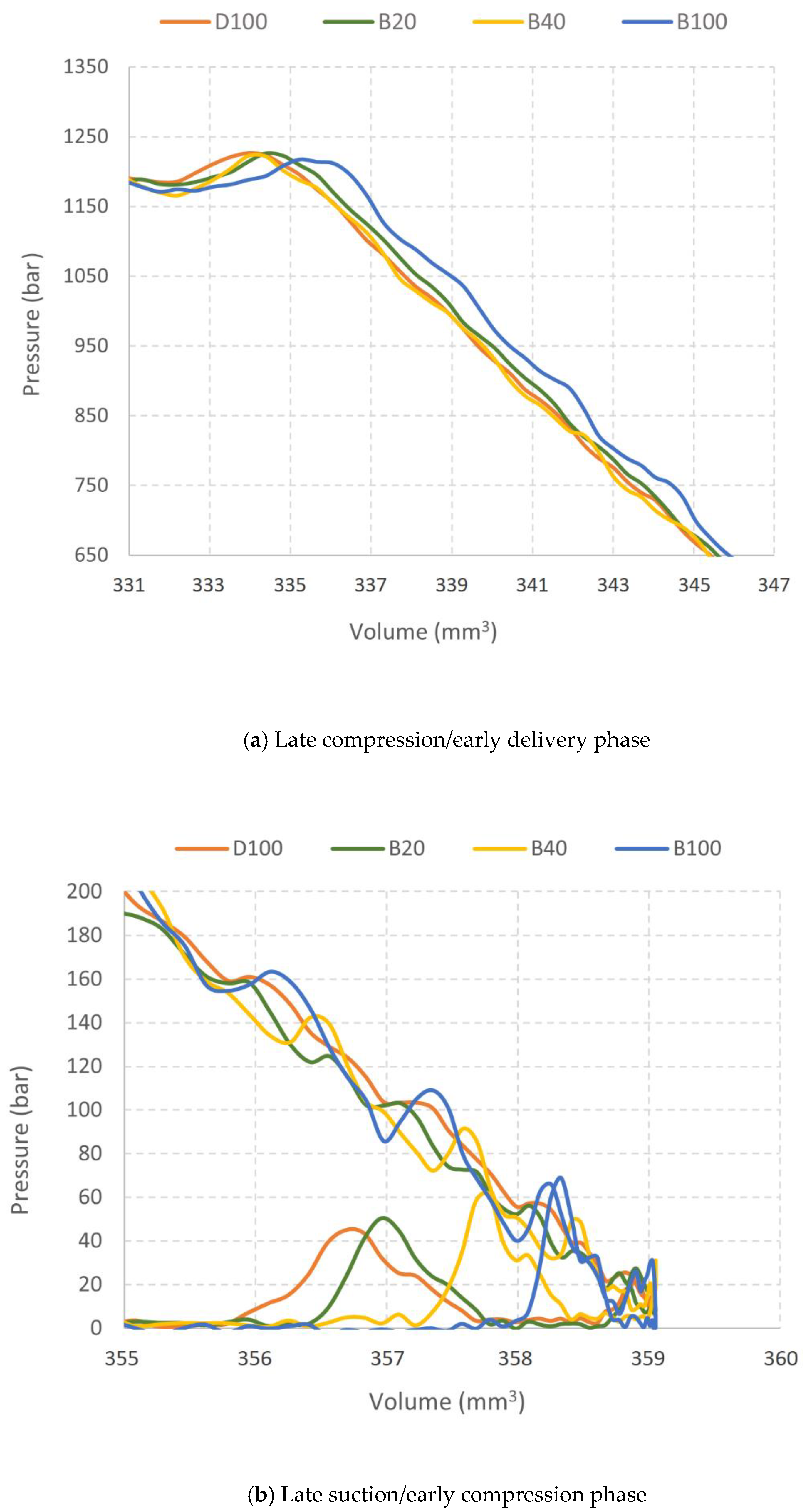

| Pump Specification | |
|---|---|
| Pump model | Bosch CP4.1 |
| Layout | Single plunger, 2-stroke per shaft revolution |
| Nominal max pressure | 1800 bar |
| Typical speed range | 900–4200 rpm |
| Nominal pump displacement | 427 mm3/rev |
| Dead volume | 75 mm3 |
| Piston diameter | 6.48 mm |
| Piston stroke | 6.49 mm |
| Pressure Measurement | |||
|---|---|---|---|
| Denomination | Sensor | Range (bar) | Signal conditioner |
| PT-Inlet | Kistler 4005 | 0–50 | Kistler 4618 |
| PT-PWC | Kistler 4067 | 0–3000 1 | Kistler 4618 |
| PT-Rail | Kistler 4067 | 0–2000 | Kistler 4618 |
| Angular Position/Rotary Speed of Pump/Drive Shaft | |||
| Denomination | Sensor | ||
| Encoder | Incremental quadrature encoder | Kübler 360 pp/rev | |
| Injection Pump Drive System | |||
| Component | Description and Specification | ||
| Electric drive | Asynchronous motor and frequency converter 11 kW 2 pole asynchronous motor and 18kW frequency converter–Full Vector Control–Siemens/Schneider Electric | ||
| DAQ System | |||
| Denomination | Description and Specification | ||
| AI module | National Instruments PXIe 5110, 2 channel digital scope–100 MHz–1Gs/s | ||
| IO module | National Instruments PXIe 6341 simultaneous multi-channel Analog-Digital Input, Counter-500 kS/s | ||
| “Diesel+” (D100)-Specifications at 40 °C | |
|---|---|
| Viscosity | 2.0 (mm2/s) |
| Density | 820 (kg/m3) |
| Bulk modulus | 1290 (MPa) |
| “WCO Biodiesel” (B100)-Specifications at 40 °C | |
| Viscosity | 4.1 (mm2/s) |
| Density | 843 (kg/m3) |
| Bulk modulus | 1415 (MPa) |
| Rail Pressure | |||
|---|---|---|---|
| Low Pressure (LP) | Medium Pressure (MP) | High Pressure (HP) | |
| 740 bar | 1170 bar | 1460 bar | |
| Pump Speed | |||
| 1500 RPM | 3000 RPM | ||
| Swept Volume (mm3)–D100–1500 RPM | |||
|---|---|---|---|
| Work Phase | High Pressure | Medium Pressure | Low Pressure |
| Compression | 31 | 24 | 16 |
| Delivery | 183 | 190 | 198 |
| Decompression | 23 | 19 | 14 |
| Suction | 191 | 195 | 200 |
| Pressure Rise During Compression Phase | ||||
|---|---|---|---|---|
| Pump speed (RPM) | Pressure level (bar) | Pressure rise rate (bar/mm3) | ||
| Pressure peak | Min | Max | ||
| 1500 | 1460 | 46 | 47 | |
| 3000 | 1535 | 35 | 58 | |
| Range of Pressure Fluctuation (bar) | ||||
| Work phase | 1500 RPM | 3000 RPM | ||
| Suction | 10 | 5 | ||
| Delivery | 207 | 173 | ||
| Compression Phases of Pure Fluids | ||||
|---|---|---|---|---|
| 3000 RPM | Swept volume (mm3) | Pressure rise rate (bar/mm3) | ||
| Min | Max | |||
| D100 | 31 | 35 | 58 | |
| B100 | 30 | 35 | 61 | |
| 1500 RPM | Swept volume (mm3) | Pressure rise rate (bar/mm3) | ||
| Min | Max | |||
| D100 | 31 | 46 | 47 | |
| B100 | 29 | 46 | 50 | |
| Range of Pressure Fluctuation (bar) | ||||
| 1500 RPM | suction | delivery | ||
| D100 | 10 | 207 | ||
| B100 | 8 | 234 | ||
| 3000 RPM | suction | delivery | ||
| D100 | 5 | 173 | ||
| B100 | 5 | 181 | ||
Publisher’s Note: MDPI stays neutral with regard to jurisdictional claims in published maps and institutional affiliations. |
© 2021 by the authors. Licensee MDPI, Basel, Switzerland. This article is an open access article distributed under the terms and conditions of the Creative Commons Attribution (CC BY) license (https://creativecommons.org/licenses/by/4.0/).
Share and Cite
Chiavola, O.; Frattini, E.; Lancione, S.; Palmieri, F. Operation Cycle of Diesel CR Injection Pump via Pressure Measurement in Piston Working Chamber. Energies 2021, 14, 5385. https://doi.org/10.3390/en14175385
Chiavola O, Frattini E, Lancione S, Palmieri F. Operation Cycle of Diesel CR Injection Pump via Pressure Measurement in Piston Working Chamber. Energies. 2021; 14(17):5385. https://doi.org/10.3390/en14175385
Chicago/Turabian StyleChiavola, Ornella, Edoardo Frattini, Simone Lancione, and Fulvio Palmieri. 2021. "Operation Cycle of Diesel CR Injection Pump via Pressure Measurement in Piston Working Chamber" Energies 14, no. 17: 5385. https://doi.org/10.3390/en14175385
APA StyleChiavola, O., Frattini, E., Lancione, S., & Palmieri, F. (2021). Operation Cycle of Diesel CR Injection Pump via Pressure Measurement in Piston Working Chamber. Energies, 14(17), 5385. https://doi.org/10.3390/en14175385








